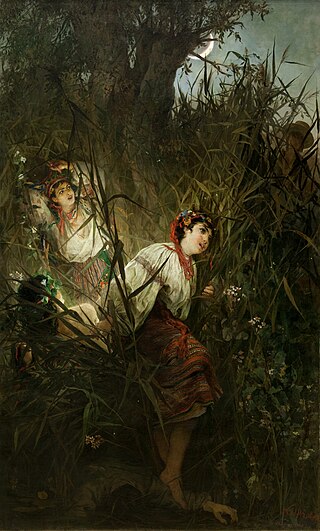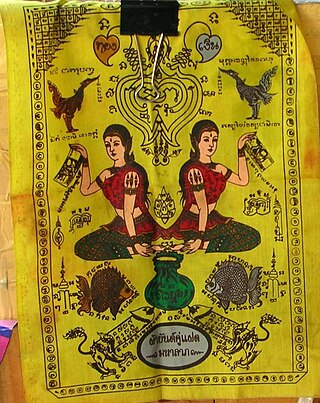A water spirit is a kind of supernatural being found in the folklore of many cultures:
A water spirit is a kind of supernatural being found in the folklore of many cultures:

Some water spirits in traditional African religion include:
In Celtic mythology:
In Greek mythology:
In Aztec belief:
In the mythology of Oceania:
In Roman mythology:
In Slavic mythology:
Apakāya ekendriya is a name used in the traditions of Jainism for Jīvas that were reincarnated as rain, dew, fog, melted snow and melted hail. [4]

In Greek mythology, the naiads are a type of female spirit, or nymph, presiding over fountains, wells, springs, streams, brooks and other bodies of fresh water.

Other than the many gods and goddesses of the Slavs, the ancient Slavs believed in and revered many supernatural beings that existed in nature. These supernatural beings in Slavic religion come in various forms, and the same name of any single being can be spelled or transliterated differently according to language and transliteration system.
Enchantress most commonly refers to:
A sprite is a supernatural entity in European mythology. They are often depicted as fairy-like creatures or as an ethereal entity.

Undines are a category of elemental beings associated with water, stemming from the alchemical writings of Paracelsus. Later writers developed the undine into a water nymph in its own right, and it continues to live in modern literature and art through such adaptations as Danish Hans Christian Andersen's 1837 "The Little Mermaid" and the 1811 novella Undine by Friedrich de la Motte Fouqué.
A jengu is a water spirit in the traditional beliefs of the Sawabantu groups of Cameroon, like the Duala, Bakweri, Malimba, Subu, Bakoko, Oroko people. Among the Bakweri, the term used is liengu. Miengu are similar to bisimbi in the Bakongo spirituality and Mami Wata. The Bakoko people use the term Bisima.

Mami Wata is a water spirit venerated in West, Central, and Southern Africa and in the Afro-American diaspora. Mami Wata spirits are usually female but are sometimes male.
In Turkic mythology, Chesma İyasi was a cat-shaped spirit who lurked in wells or fountains and tempted youths to their deaths. As a female spirit that resides in water, she can be seen as a type of naiad.
Mythic humanoids are legendary, folkloric, or mythological creatures that are part human, or that resemble humans through appearance or character. Each culture has different mythical creatures that come from many different origins, and many of these creatures are humanoids. They are often able to talk and in many stories they guide the hero on their journey.

Bantu religion is the system of beliefs and legends of the Bantu people of Africa. Although Bantu peoples account for several hundred different ethnic groups, there is a high degree of homogeneity in Bantu cultures and customs, just as in Bantu languages. Many Bantu cultures traditionally believed in a supreme god whose name is a variation of Nyambe/Nzambe.

West African mythology is the body of myths of the people of West Africa. It consists of tales of various deities, beings, legendary creatures, heroes and folktales from various ethnic groups. Some of these myths traveled across the Atlantic during the period of the Trans-Atlantic slave trade to become part of Caribbean, African-American and Brazilian mythology.

Thai folklore is a diverse set of mythology and traditional beliefs held by the Thai people. Most Thai folklore has a regional background for it originated in rural Thailand. With the passing of time, and through the influence of the media, large parts of Thai folklore have become interwoven with the wider popular Thai culture.

Belief in ghosts in Thai culture is both popular and enduring. In the history of Thailand, Buddhist popular beliefs intermingled with legends of spirits or ghosts of local folklore. These myths have survived and evolved, having been adapted to the modern media, such as Thai films, Thai television soap operas, and Thai comics.

Skin of the Sea is a 2021 young adult fantasy novel by Nigerian Welsh writer Natasha Bowen. Bowen's debut novel follows Simi, a mami wata who travels across sea and land in search of the Supreme Creator after breaking a law that threatens the existence of all mami wata.